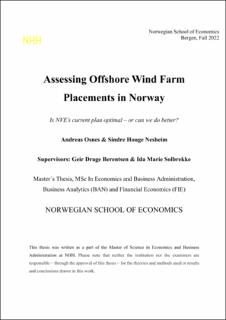Assessing Offshore Wind Farm Placements in Norway Is NVE’s current plan optimal – or can we do better?
Master thesis
Permanent lenke
https://hdl.handle.net/11250/3051991Utgivelsesdato
2022Metadata
Vis full innførselSamlinger
- Master Thesis [4372]
Sammendrag
Over the last decade, offshore wind has received increased attention due to global warming
and the increase in energy demand. Therefore, it is of the highest interest to develop more
renewable energy production to satisfy the increase in energy consumption and reduce global
pollution. Even though Norway has excellent hydropower opportunities and is self-sufficient
and a leading prosecutor in this field, developing offshore wind is now a goal. In 2020, the
Norwegian government opened for wind farm development in Sørlige Nordsjø II and Utsira
Nord. The government is also planning to delegate licenses for around 30 gigawatts of offshore
wind by 2040. Luckily enough, as we will see throughout this thesis, the Norwegian wind
conditions are outstanding for wind power production. Additionally, the technologies
surrounding offshore wind farms have become drastically better, making them both more
affordable and effective.
This paper aims to explore and perform statistical analyses on potential sites for offshore wind
farms in Norway. The thesis will have an “investor perspective” and seek optimal locations to
maximise production while minimizing variability and costs. As already mentioned, Sørlige
Nordsjø II and Utsira Nord are open for production. We want to use these locations as
baselines when researching the other areas to see whether one can outperform them. After
selecting our locations through a qualitative analysis, we use the dataset NORA3-WP to
explore the maximum power production and create portfolios from the selected locations.
Objectively, it is hard to determine whether some locations are better than others, but we have
overcome some findings. The interpretation from the results is that the South of Lindesnes is
stand-alone best in terms of power production and Sharpe ratio. The portfolio evaluation
showed that a combination of all the locations except Utsira Nord creates a minimum varianceand
a maximum Sharpe ratio–portfolio. We also provide three scenarios with different weights
for locations that would satisfy the government’s goal of producing 120 TWh within 2040.
Notably, this thesis is heavily influenced by the “investor perspective”, and the calculations
are massively simplified. Further and broader research would be necessary before making any
final decisions.
